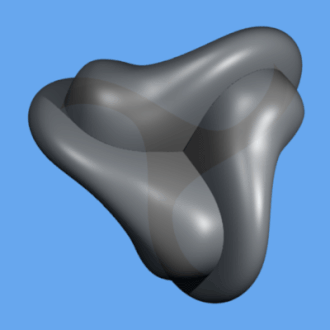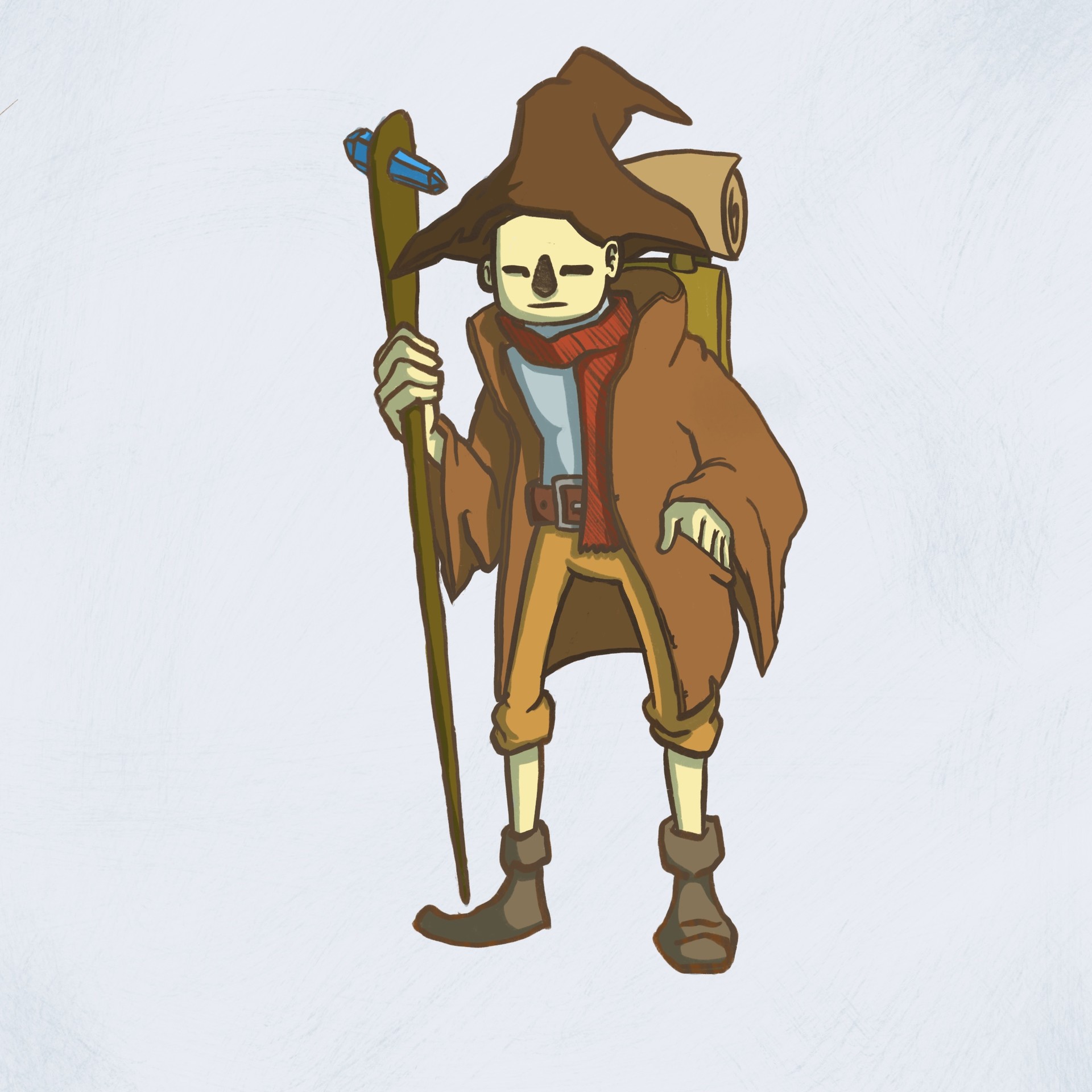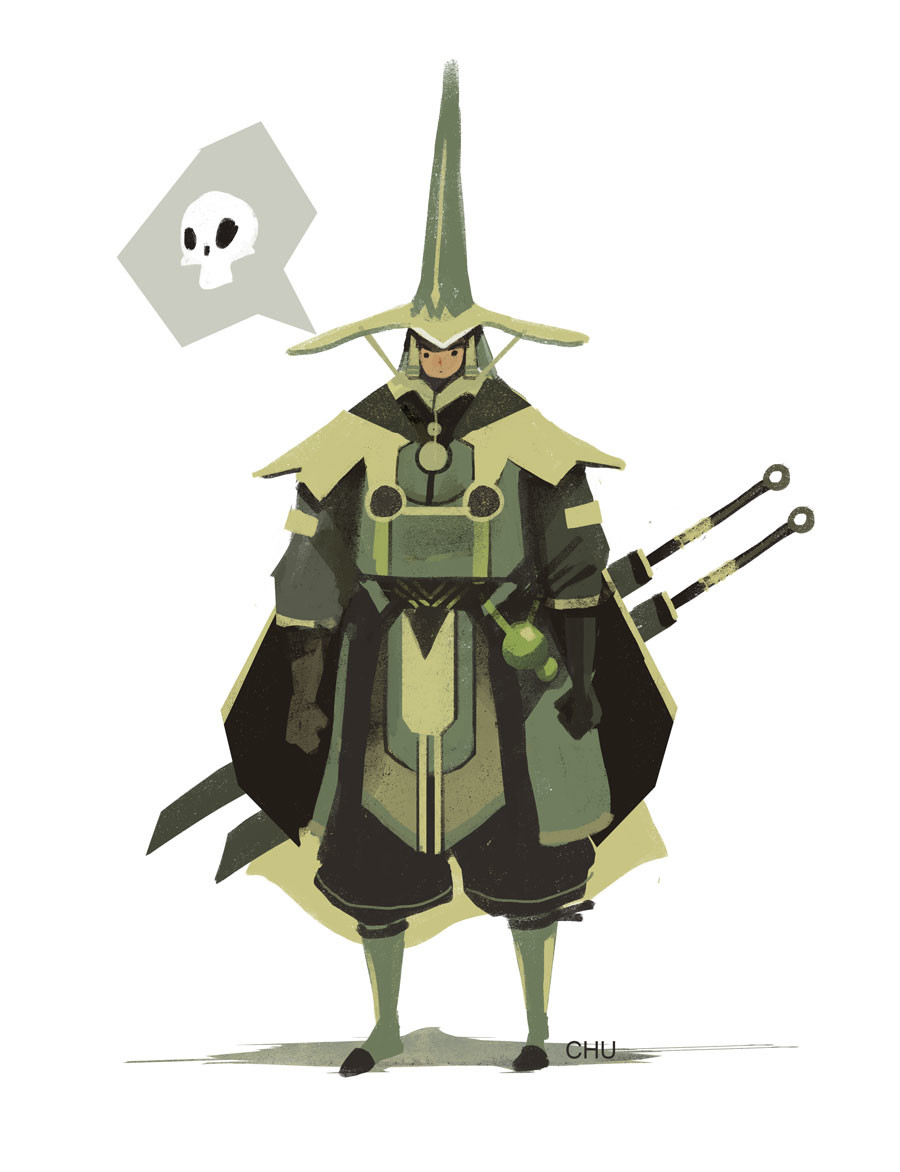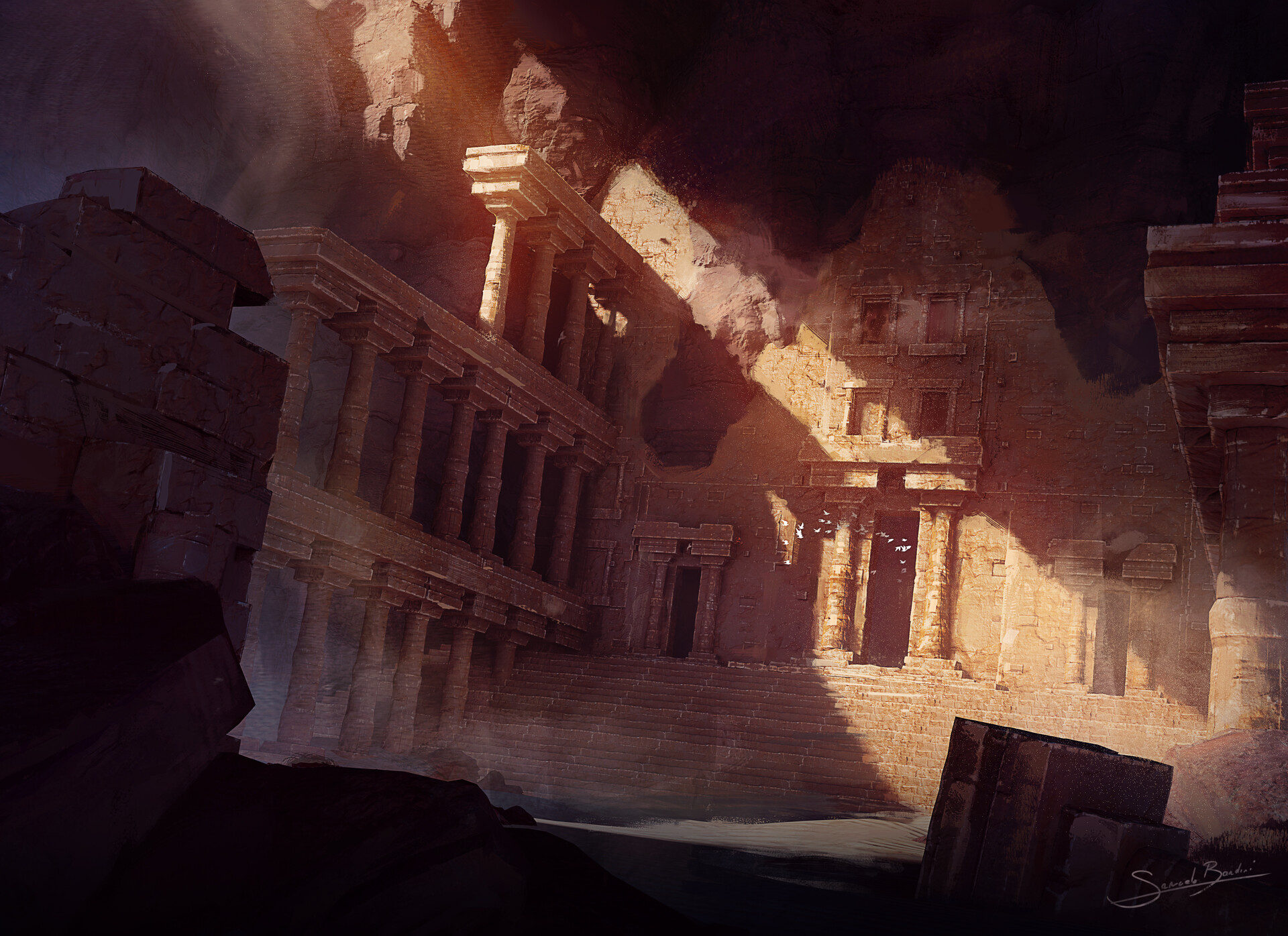In the beginning, Mother Sun measured out the heavens and the earth with Father Moon.
Some of the surviving depictions show her as a man, but why not? Mother Sun can assume any shape when the feeling seizes her.
_British_Museum.jpg/1200px-Europe_a_Prophecy%2C_copy_D%2C_object_1_(Bentley_1%2C_Erdman_i%2C_Keynes_i)_British_Museum.jpg) |
| The Ancient of Days by William Blake |
She measured and partitioned the earth with a compass and a right angle. Father Moon double-checked her work, but that took several thousand years, and in the mean time some errors magnified themselves. Any first draft of code is riddled with typos and confunding logic that looked pretty good at 1 in the morning, but Mother Sun was impatient. She wanted to see the breasts of her creations rise and fall, to watch them use the convoluted jelly orbs she gave them to admire her handiwork.
Today, the Solar Geometers travel around the known world, measuring plants and animals, categorizing and analyzing the spread of infections, and dropping balls of different weights from buildings, checking and rechecking, transcribing, publishing, working. Their traditional homes are the Equinoxes and Solstices of Bblyns, 4 shining towers to catch the rays of the 4 auspicious moments.
Understanding that a^2 + b^2 = c^2 allows you to rewrite the equation. Magic is intentionally unbalancing one side of an equation to produce something out of nothing, negate a process, or square root a giant. If 1 +1 = 3, and 3 +3 = 8, what can you do with the excess energy?
The simpler the equation, the easier it is to unbalance. Magic effects often require extremely convoluted equations. (Try mathematically modeling a Fireball.)
Modeled off Arnold's rules but compatible with Skerples's adaptation.
Modeled off Arnold's rules but compatible with Skerples's adaptation.
Order of Solar Geometers
Perk: If you are casting with sunlight on you, your MD return to your pool on a roll of 1-4.
Drawback: Every time you cast a spell without facing one of the four cardinal directions, you must Save or take [dice] penalty to (1d4): a) inventory slots b) HP c) damage d) skill checks for [dice] minutes. The world does not like making something out of nothing for you.
You start with a geometric compass, a magnetic compass, a right angle, and some fancy colored chalk.
Cantrips:
1. Know the exact angle and distance to a point you can see.
2. Instantly count how many objects are in a pile.
3. Spells you cast may treat their point of origin as a circle you drew that you can see.
Solar Geometer Spell List:
3. Spells you cast may treat their point of origin as a circle you drew that you can see.
Solar Geometer Spell List:
1. Magic Missile*
R: 200' T: creature D: 0
R: 200' T: creature D: 0
Target takes [sum] + [dice] damage, no Save. Your magic missile is a small wormhole.
2. Congruence
R: 30' T: creature/object D: [dice] minutes
You alter a creature's or an object's shape and size to mimic that of another creature/object you can see. If 4 or more dice are invested, this spell is permanent.
3. Remeasure
R: 30' T: creature/object D: [sum] minutes
You correct [dice] physical anomalies (mutations and the like) on a creature. If 4 or more dice are invested, this spell is permanent.
4. Speak With Planes
R: Self T: planes D: [dice] rounds
Your brain warps to allow communication with localized representations of either length, width, depth, or time. They are neutral to your presence unless you have done some great favor for them or offended them. Length, width, and depth measure things by how much of a length, width, and depth the thing has relevant to the local direction of gravity and the local units of measurement. Time will let you view the last [dice] minutes in an area if you ask nicely.
5. Sunlust
R: 30' T: [dice] creatures D: [dice] rounds
Creatures that can see sunlight must Save or rush towards it.
6. Illumination
R: touch T: creature D: 0
A creature you touch has a sudden flash of insight or can make a Save against a confusing or befuddling effect.
7. Solar Flare
R: self T: [dice] creatures D: [dice] rounds
Creatures that can see you must Save or be blinded by a flash of sunlight.
8. Binding Ray
R: 100' T: creature D: [dice] rounds
One creature or object that you choose must Save or be struck by a 2-dimensional line, take [dice] damage, and be tethered to your index finger. The ray can "reflect" off of corners with angles ranging from 90 degrees to 180 degrees if the target is within range but not within sight. The line is invisible due to its two dimensional nature, but can be cut.
9. Sunkissed
R: touch T: [dice] creatures D: [dice] x 2 hours
Creatures (including yourself) that you touch are comfortable in temperatures up to 150 degrees Fahrenheit, need half as much water for the duration, can't suffer from heatstroke, and can't be harmed by fires smaller than a torch.
10. Numbersect
R: 200' T: [dice] x 5' D: 0
Creatures or objects within the radius must Save or be divided into [dice] +1 sections of the same mass and similar shape as possible.
Sidebar: Blinded
Blinded creatures cannot do anything that requires sight like reading. They automatically miss with ranged attacks and have a +5 penalty on melee weapon attacks.
If blinded creatures spend a round listening, they may make a ranged weapon attack with a +5 penalty, but only if their target is making noise and there isn't too much background noise.
Emblem Spells
11. Immolation
R: [dice] x 10' T: creatures D: [sum] rounds, concentration
All creatures within range must Save or take [dice]d4 heat damage each round. Small objects spontaneously catch on fire if flammable, and water boils away. You incandesce enough that creatures cannot perceive you. A creature reduced to 0 hit points by this spell is riven from within by shafts of sunlight and explodes, dealing [dice] damage to adjacent creatures.
12. Dimenopsia
R: touch T: creature D: [sum] rounds
You rob someone of their ability to perceive dimension. If they fail a Save against this spell, roll on the table below. If [sum] > 18, this is permanent.
1d4:
1. The creature loses its ability to perceive or conceive of depth. It treats all things as if they were the same distance away.
2. The creature loses its ability to perceive or conceive of length. It cannot distinguish between two dowels of the same material and width but of different length, for example.
3. The creature loses its ability to perceive or conceive of width.
4. The creature loses its ability to perceive or conceive of time.
Alternatively, this spell can also be used to correct strong dimensional anomalies within a radius of [dice] x 10'.
Solar Geometer Mishaps
1. MD only return to your pool on a roll of 1-2 for 24 hours.
2. Take 1d6 damage.
3. Random mutation for 1d6 rounds, then Save. Permanent if you fail.
4. Blinded for 1d6 rounds.
5. No depth perception for 24 hours.
6. An ally loses their ability to perceive any object with an angle less than 90 degrees for a day.
Doom of the Solar Geometer
1. Become two-dimensional for a day. Handy if you walk sideways, but watch out for winds.
2. You become adrift in time for what feels like an eternity. Roll 1d20. On an odd roll, you return that many hours in the past in a random, survivable spot 100 feet away from where you were in the past. On an even roll, you are catapulted that many hours to the future 100 feet in a survivable location away from where you are going to be. After the number of hours stipulated in your temporal journey elapse, one of you vanishes.
Until then, there are two of yourself, and if anyone (including yourself) besides you becomes aware of that, 1d4 +1 paradox angels sent by Mother Sun arrive to exterminate both you's and anyone else in the vicinity.
3. You are reduced to a 1-dimensional point. Choose one of the four dimensions. You disappear, become an invisible, infinitesimally small dot, and are only able to view that dimension.
This doom can be avoided by obtaining the direct blessing of Mother Sun or by writing down every fundamental law of her world.
5e: School of Solar Geometers
Khayyamite
At 2nd level, when you choose this tradition, your spells interact differently with angles. Spells cast by you that require a ranged attack roll can reflect off of acute and right angles formed by straight lines of your choice, potentially around corners.
Compass
Starting at 6th level, you always know how high the sun is in the sky and which direction is west, even if underground. In addition, you may change fire damage to radiant damage when you cast a spell of 1st level or higher.
Bilateral
At 10th level, you learn how to split your spells. As a bonus action, when you cast a spell that targets only one creature and doesn't have a range of self, you can simultaneously expend a spell slot of the same level or higher (1st level for cantrips) to duplicate the spell.
This ability recharges after a short or long rest.
Heliophile
Beginning at 14th level, you regain hit points equal to your Constitution modifier when you start your turn with less than half your hit points if you are exposed to sunlight. This ability does not work if you are reduced to 0 hit points.
As always, feedback welcome! This is a wizard tradition I've had rattling around my skull for a long, long time.
R: 30' T: creature/object D: [dice] minutes
You alter a creature's or an object's shape and size to mimic that of another creature/object you can see. If 4 or more dice are invested, this spell is permanent.
3. Remeasure
R: 30' T: creature/object D: [sum] minutes
You correct [dice] physical anomalies (mutations and the like) on a creature. If 4 or more dice are invested, this spell is permanent.
4. Speak With Planes
R: Self T: planes D: [dice] rounds
Your brain warps to allow communication with localized representations of either length, width, depth, or time. They are neutral to your presence unless you have done some great favor for them or offended them. Length, width, and depth measure things by how much of a length, width, and depth the thing has relevant to the local direction of gravity and the local units of measurement. Time will let you view the last [dice] minutes in an area if you ask nicely.
5. Sunlust
R: 30' T: [dice] creatures D: [dice] rounds
Creatures that can see sunlight must Save or rush towards it.
6. Illumination
R: touch T: creature D: 0
A creature you touch has a sudden flash of insight or can make a Save against a confusing or befuddling effect.
7. Solar Flare
R: self T: [dice] creatures D: [dice] rounds
Creatures that can see you must Save or be blinded by a flash of sunlight.
8. Binding Ray
R: 100' T: creature D: [dice] rounds
One creature or object that you choose must Save or be struck by a 2-dimensional line, take [dice] damage, and be tethered to your index finger. The ray can "reflect" off of corners with angles ranging from 90 degrees to 180 degrees if the target is within range but not within sight. The line is invisible due to its two dimensional nature, but can be cut.
9. Sunkissed
R: touch T: [dice] creatures D: [dice] x 2 hours
Creatures (including yourself) that you touch are comfortable in temperatures up to 150 degrees Fahrenheit, need half as much water for the duration, can't suffer from heatstroke, and can't be harmed by fires smaller than a torch.
10. Numbersect
R: 200' T: [dice] x 5' D: 0
Creatures or objects within the radius must Save or be divided into [dice] +1 sections of the same mass and similar shape as possible.
Sidebar: Blinded
Blinded creatures cannot do anything that requires sight like reading. They automatically miss with ranged attacks and have a +5 penalty on melee weapon attacks.
If blinded creatures spend a round listening, they may make a ranged weapon attack with a +5 penalty, but only if their target is making noise and there isn't too much background noise.
 |
| Boy's surface: a representation of a one-sided surface in 3-dimensional space |
Emblem Spells
11. Immolation
R: [dice] x 10' T: creatures D: [sum] rounds, concentration
All creatures within range must Save or take [dice]d4 heat damage each round. Small objects spontaneously catch on fire if flammable, and water boils away. You incandesce enough that creatures cannot perceive you. A creature reduced to 0 hit points by this spell is riven from within by shafts of sunlight and explodes, dealing [dice] damage to adjacent creatures.
12. Dimenopsia
R: touch T: creature D: [sum] rounds
You rob someone of their ability to perceive dimension. If they fail a Save against this spell, roll on the table below. If [sum] > 18, this is permanent.
1d4:
1. The creature loses its ability to perceive or conceive of depth. It treats all things as if they were the same distance away.
2. The creature loses its ability to perceive or conceive of length. It cannot distinguish between two dowels of the same material and width but of different length, for example.
3. The creature loses its ability to perceive or conceive of width.
4. The creature loses its ability to perceive or conceive of time.
Alternatively, this spell can also be used to correct strong dimensional anomalies within a radius of [dice] x 10'.
Solar Geometer Mishaps
1. MD only return to your pool on a roll of 1-2 for 24 hours.
2. Take 1d6 damage.
3. Random mutation for 1d6 rounds, then Save. Permanent if you fail.
4. Blinded for 1d6 rounds.
5. No depth perception for 24 hours.
6. An ally loses their ability to perceive any object with an angle less than 90 degrees for a day.
Doom of the Solar Geometer
1. Become two-dimensional for a day. Handy if you walk sideways, but watch out for winds.
2. You become adrift in time for what feels like an eternity. Roll 1d20. On an odd roll, you return that many hours in the past in a random, survivable spot 100 feet away from where you were in the past. On an even roll, you are catapulted that many hours to the future 100 feet in a survivable location away from where you are going to be. After the number of hours stipulated in your temporal journey elapse, one of you vanishes.
Until then, there are two of yourself, and if anyone (including yourself) besides you becomes aware of that, 1d4 +1 paradox angels sent by Mother Sun arrive to exterminate both you's and anyone else in the vicinity.
3. You are reduced to a 1-dimensional point. Choose one of the four dimensions. You disappear, become an invisible, infinitesimally small dot, and are only able to view that dimension.
This doom can be avoided by obtaining the direct blessing of Mother Sun or by writing down every fundamental law of her world.
 |
| Gabriel's Horn - possesses infinite surface area but finite volume |
5e: School of Solar Geometers
Khayyamite
At 2nd level, when you choose this tradition, your spells interact differently with angles. Spells cast by you that require a ranged attack roll can reflect off of acute and right angles formed by straight lines of your choice, potentially around corners.
Compass
Starting at 6th level, you always know how high the sun is in the sky and which direction is west, even if underground. In addition, you may change fire damage to radiant damage when you cast a spell of 1st level or higher.
Bilateral
At 10th level, you learn how to split your spells. As a bonus action, when you cast a spell that targets only one creature and doesn't have a range of self, you can simultaneously expend a spell slot of the same level or higher (1st level for cantrips) to duplicate the spell.
This ability recharges after a short or long rest.
Heliophile
Beginning at 14th level, you regain hit points equal to your Constitution modifier when you start your turn with less than half your hit points if you are exposed to sunlight. This ability does not work if you are reduced to 0 hit points.
As always, feedback welcome! This is a wizard tradition I've had rattling around my skull for a long, long time.








